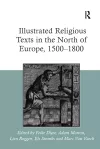
Illustrated Religious Texts in the North of Europe, 1500-1800
3 authors - Hardback
£145.00
Feike Dietz is Assistant Professor in Early Modern Dutch Literature and Culture at Utrecht University. Her PhD project focused on the interconfessional exchange of illustrated religious literature in the Dutch Republic. This topic has been the focus of several articles and her book Literaire levensaders. Internationale uitwisseling van woord, beeld en religie in de Republiek (Literary Lifelines. The International Exchange of Word, Image and Religion in the Dutch Republic). Adam Morton is a Post-Doctoral Fellow at the University of Oxford. He previously worked at the Universities of Warwick and York. He researches anti-Catholicism and visual culture in Reformation England, and has published several articles as well as a volume on post-Reformation confessional identities, Getting Along? Religious Identities and Confessional Relations in Early Modern England (Ashgate, 2011). He is currently transforming his PhD thesis into a monograph. Lien Roggen studied Germanic Languages at the Catholic University of Leuven and is currently finishing her PhD on the emblematic oeuvre of the Flemish Jesuit Adriaan Poirters (1605-1674). Lien’s research focuses especially on Poirters’ appropriating of prints from a Latin context and his constant rewriting of his own work in which the relation between text and image changes in order to meet his Dutch readership. Els Stronks is Professor of Early Modern Dutch Literature and Culture at Utrecht University. She previously taught at Indiana University. She is the author of several articles and books. Her recent monograph, Negotiating Differences: Word, Image and Religion in the Dutch Republic, discusses how the first centuries of illustrated religious literature in the Northern Netherlands reveal patterns of social behaviour and confessional identity formation. Marc Van Vaeck is Professor of Early Modern Dutch Literature at the Catholic University of Leuven. He is the author of numerous articles on religious emblematics, and co-edi